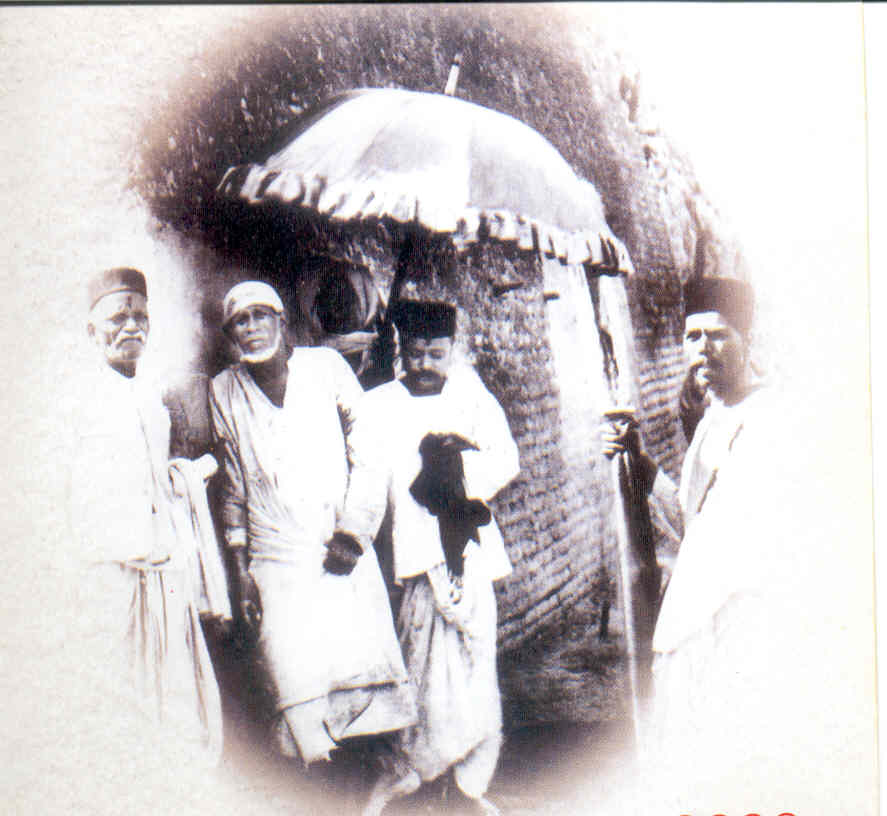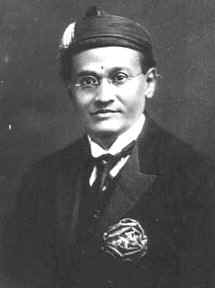 SABURI
SABURI
 SABURI
SABURI
Shirdi Sai Dwaaraka Maayee Prashanthi Vaasi Sai Ram Sai Ram Sai Ram, Ek Naam Sundara Naam Shirdi Sai Dwaaraka Maayee Prashanthi Vaasi Sai Ram Allah Eshwara Sai Ram Parthipuri Key Hey Bhagawaan Daya Karo Daya Karo Daya Karo Hey Bhagawaan Daya Karo Kripa Karo Raksha Karo Hey Bhagawaan Sai Ram Sai Ram, Ek Naam Sundara Naam (Oh Lord Shirdi Sai of Dwaaraka, Oh Lord Sai Ram of Prashanthi (Nilayam), You are known by one beautiful name 'Sai Ram'. You are Allah, You are Eshwara (Lord Shiva), You are the Lord of Parthipuri (Parthi). Please have mercy on us, please be kind to us, please protect us)

|
SHRI SAI SATHCHARITHA"Sada Nimbarvrikshasya mooladhiwasat, Sudhasravinam tiktamapi-apriyam tam, Tarum Kalpavrikshadhikam sadhayantam Namameeshwaram Sadgurum Sai Natham" |

|
Kakasahebmahajani |
Chapter VI |
Radhakrishnaswami |
Shri Sai Satcharitra
Chapter VI
Transformation of Urus into Rama-Navami Festival
T
hings were going on in this way and the fair was gradually increasing in importance till 1912 A.D., when a change took place; That year one devotee, Mr. Krishnarao Jageshwar Bhisma (the author of the pamphlet 'Sai Sagunopasana'), came for the fair with Dadasaheb Khaparde of Amraoti, and was staying on the previous day in the Dixit Wada. While he was lying on the verandah, and while Mr. Laxmanrao alias Kaka Mahajani, was going down with Puja materials to the Masjid, a new thought arose in his mind and he accosted the latter thus - There is some providential arrangement in the fact that the Urus or fair is celebrated in Shirdi on the Rama-Navami day; this day is very dear to all the Hindus; then why not begin the Rama-Navami Festival - the celebration of the birth of Shri Rama here on this day? Kaka Mahajani liked the idea, and it was arranged to get Baba's permission in this matter. The main difficulty was how to secure a Haridas, who would perform 'Kirtan' and sing the glories of the Lord on the occasion. But Bhishma solved the difficulty, by saying that his 'Rama Akhyan' (composition on Rama's birth) was ready, and he would do the 'Kirtan' himself, while Kaka Mahajani should play on the harmonium. It was also arranged to get the 'Sunthavada' (ginger-powder mixed with sugar) as Prasad prepared by Radha-Krishna Mai. So they immediately went to the Masjid to get Baba's permission. Baba, who knew all things and what was passing there, asked Mahajani, as to what was going on in the Wada. Being rather perturbed, Mahajani could not catch the purport of the question and remained silent. Then Baba asked Bhishma, what he had to say. He explained the idea of celebrating Rama-Navami festival, and asked for Baba's permission and Baba gladly gave it. All rejoiced and made preparations for the Jayanti-festival. Next day, the Masjid was decorated with buntings etc., a cradle was supplied by Radha-Krishna Mai, and placed in front of Baba's seat and the proceedings started. Bhishma stood up for Kirtan and Mahajani played on the harmonium. Sai Baba sent a man to call Mahajani. He was hesitating to go, doubting whether Baba would allow the festival to go on; but when he went to Baba, the latter asked him as to what was going on and why the cradle was placed there. He answered that the Rama-Navami festival had commenced, and the cradle was put on for that purpose. Then Baba took a garland from the 'Nimbar' (nitche), and placed it round his neck and sent another garland for Bhishma. Then commenced the Kirtan. When it came to a close, pound sounds of "Victory to Rama" went up; and Gulal (red - powder) was thrown up all round, amidst band and music. Everybody was overjoyed, when suddenly roaring was heard. The red-powder thrown promiscuously all round, went up, somehow entered Baba's eyes. Baba got wild and began to scold and abuse loudly. People got frightened by this scene and took to their heels. Those intimate devotees, who knew Baba well, took these scoldings and outpourings of Baba, as blessings in disguise. They thought that when Rama was born, it was proper for Baba to get wild and enraged to kill Ravana; and his demons, in the form of egoism and wicked thoughts etc. Besides they knew, that whenever a new thing was undertaken at Shirdi, it was usual with Baba to get wild and angry, and so they kept quiet. Radha-Krishna Mai was rather afraid; and thought that Baba might break her cradle, and she asked Mahajani to get the cradle back. When he went to loosen and unfasten the cradle, Baba went to him, and asked him not to remove it. Then after some time, Baba became calm, and that day's programme, including Mahapuja and Arati was finished. Later on, Mr. Mahajani asked Baba, for permission to remove the cradle, Baba refused the same saying, that the festival was not yet finished. Next day, another 'Kirtan' and Gopal-Kala ceremony (an earthern pot containing parched rice mixed with curds is hung, only to be broken after the 'Kirtan', and the contents distributed to all, as was done by Lord Kri shna amongst His cow-herd (friends), were performed, and then Baba allowed the cradle to be removed. While the Rama-Navami festival was thus going on, the procession, of the two flags by day and that of the 'Sandal' by night, went off with the usual pomp and show. From this time onwards, the 'Urus of Baba' was transformed into the Rama-Navami festival.From next year (1913), the items in the programme of Rama-Navami began to increase. Radha-Krishna Mai started a 'Nama-Saptah' (singing the glory of God's name continuously day and night for seven days), from 1st of Chaitra, For this, all devotees took part by turns, and she also joined it, sometimes early in the morning. As Rama-Navami Festival is celebrated in many places all over the country, the difficulty of getting a Haridas was felt again. But 5 or 6 days before the festival , Mahajani met accidentally Balabuva Mali, who was known as modern Tukaram, and got him to do the 'Kirtan' that year. The next year (1914), another Balabuva Satarkar of Brihadsiddha Kavate, District Satara, could not act as a Haridas in his own town, as plague was prevailing in his town, and so he came to Shirdi; With Baba's permission, which was secured through Kakasaheb Dixit, he did the Kirtan; and was sufficiently recompensed for his labour. The difficulty of getting a new Haridas every year was finally solved from 1914 by Sai Baba, as He entrusted this function to Das Ganu Maharaj permanently, and since that time, he has been successfully and creditably conducting that function uptill now.
Since 1912, this festival began to grow gradually year by year. From the 8th to 12th of Chaitra, Shirdi looked like a bee-hive of men. Shops began to increase. Celebrated wrestlers took part in wrestling bouts. Feeding of the poor was done on a grander scale. Hard work and sincere efforts of Radha-Krishna Mai turned Shirdi into a Sansthan (State). Paraphernalia increased. A beautiful horse, a palanquin, chariot and many silver things, pots, buckets, pictures, mirrors etc. were presented. Elephants were also sent for the procession. Though all this paraphernalia increased enormously, Sai Baba ignored all these things, and maintained His simplicity as before. It is to be noted that both the Hindus and Mahomedans have been working in unison in both the processions, and during the entire festival, there has been no hitch or quarrel between them at all so far. First about 5000-7000 people used to collect, but that figure went up to 75000 in some years; still there was no outbreak of any epidemic or any riots w orth the name during so many past years.